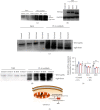Acetylation of Atp5f1c Mediates Cardiomyocyte Senescence via Metabolic Dysfunction in Radiation-Induced Heart Damage
- PMID: 36160705
- PMCID: PMC9499811
- DOI: 10.1155/2022/4155565
Acetylation of Atp5f1c Mediates Cardiomyocyte Senescence via Metabolic Dysfunction in Radiation-Induced Heart Damage
Abstract
Objective: Ionizing radiation (IR) causes cardiac senescence, which eventually manifests as radiation-induced heart damage (RIHD). This study is aimed at exploring the mechanisms underlying IR-induced senescence using acetylation proteomics.
Methods: Irradiated mouse hearts and H9C2 cells were harvested for senescence detection. Acetylation proteomics was used to investigate alterations in lysine acetylation. Atp5f1c acetylation after IR was verified using coimmunoprecipitation (Co-IP). Atp5f1c lysine 55 site acetylation (Atp5f1c K55-Ac) point mutation plasmids were used to evaluate the influence of Atp5f1c K55-Ac on energy metabolism and cellular senescence. Deacetylation inhibitors, plasmids, and siRNA transfection were used to determine the mechanism of Atp5f1c K55-Ac regulation.
Results: The mice showed cardiomyocyte and cardiac aging phenotypes after IR. We identified 90 lysine acetylation sites from 70 protein alterations in the heart in response to IR. Hyperacetylated proteins are primarily involved in energy metabolism. Among them, Atp5f1c was hyperacetylated, as confirmed by Co-IP. Atp5f1c K55-Ac decreased ATP enzyme activity and synthesis. Atp5f1c K55 acetylation induced cardiomyocyte senescence, and Sirt4 and Sirt5 regulated Atp5f1c K55 deacetylation.
Conclusion: Our findings reveal a mechanism of RIHD through which Atp5f1c K55-Ac leads to cardiac aging and Sirt4 or Sirt5 modulates Atp5f1c acetylation. Therefore, the regulation of Atp5f1c K55-Ac might be a potential target for the treatment of RIHD.
Copyright © 2022 Zhimin Zeng et al.
Conflict of interest statement
The authors declare that they have no competing interests.
Figures






Similar articles
-
Acetylation of FABP3 alleviates radioimmunotherapy-induced cardiomyocyte senescence by modulating long-chain polyunsaturated fatty acid metabolism.Int Immunopharmacol. 2025 Jul 28;160:114912. doi: 10.1016/j.intimp.2025.114912. Epub 2025 May 30. Int Immunopharmacol. 2025. PMID: 40449275
-
Acetylation of PGC1α by Histone Deacetylase 1 Downregulation Is Implicated in Radiation-Induced Senescence of Brain Endothelial Cells.J Gerontol A Biol Sci Med Sci. 2019 May 16;74(6):787-793. doi: 10.1093/gerona/gly167. J Gerontol A Biol Sci Med Sci. 2019. PMID: 30016403
-
Total extracts from Abelmoschus manihot (L.) alleviate radiation-induced cardiomyocyte ferroptosis via regulating redox imbalances mediated by the NOX4/xCT/GPX4 axis.J Ethnopharmacol. 2024 Nov 15;334:118582. doi: 10.1016/j.jep.2024.118582. Epub 2024 Jul 14. J Ethnopharmacol. 2024. PMID: 39009325
-
Cardiomyocyte Senescence and Cellular Communications Within Myocardial Microenvironments.Front Endocrinol (Lausanne). 2020 May 21;11:280. doi: 10.3389/fendo.2020.00280. eCollection 2020. Front Endocrinol (Lausanne). 2020. PMID: 32508749 Free PMC article. Review.
-
Acetylation of Mitochondrial Proteins in the Heart: The Role of SIRT3.Front Physiol. 2018 Aug 7;9:1094. doi: 10.3389/fphys.2018.01094. eCollection 2018. Front Physiol. 2018. PMID: 30131726 Free PMC article. Review.
Cited by
-
Spatially resolved transcriptomic profiling of placental development in dairy cow.Zool Res. 2024 May 18;45(3):586-600. doi: 10.24272/j.issn.2095-8137.2023.205. Zool Res. 2024. PMID: 38766743 Free PMC article.
-
An integrative review of nonobvious puzzles of cellular and molecular cardiooncology.Cell Mol Biol Lett. 2023 May 23;28(1):44. doi: 10.1186/s11658-023-00451-y. Cell Mol Biol Lett. 2023. PMID: 37221467 Free PMC article. Review.
-
Sirtuin 5 regulates acute myeloid leukemia cell viability and apoptosis by succinylation modification of glycine decarboxylase.Open Life Sci. 2024 Mar 16;19(1):20220832. doi: 10.1515/biol-2022-0832. eCollection 2024. Open Life Sci. 2024. PMID: 38585637 Free PMC article.
-
Mitochondrial sirtuins, key regulators of aging.Life Med. 2025 Jun 9;4(4):lnaf019. doi: 10.1093/lifemedi/lnaf019. eCollection 2025 Aug. Life Med. 2025. PMID: 40799515 Free PMC article. Review.
-
Mechanisms of radiation-induced tissue damage and response.MedComm (2020). 2024 Sep 20;5(10):e725. doi: 10.1002/mco2.725. eCollection 2024 Oct. MedComm (2020). 2024. PMID: 39309694 Free PMC article. Review.
References
-
- Le Pechoux C., Pourel N., Barlesi F., et al. Postoperative radiotherapy versus no postoperative radiotherapy in patients with completely resected non-small-cell lung cancer and proven mediastinal N2 involvement (Lung ART, IFCT 0503): an open-label, randomised, phase 3 trial. Oncologia . 2022;23(1):104–114. doi: 10.1016/S1470-2045(21)00606-9. - DOI - PubMed
MeSH terms
Substances
LinkOut - more resources
Full Text Sources
Molecular Biology Databases

